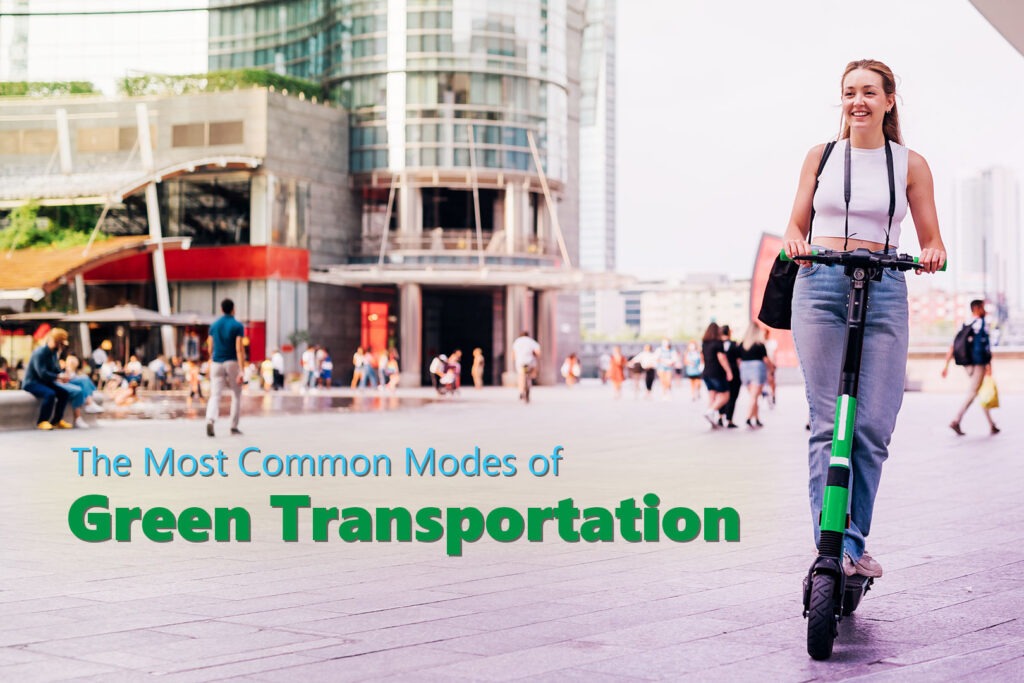
According to the Environmental Protection Agency (EPA), transportation is the largest contributor to greenhouse gas emissions in the United States, accounting for 29% of all emissions. While there are efforts to curb emissions from the transportation sector by setting emissions standards for cars and trucks, there are some more robust sustainable transportation alternatives available.
Whether you’re looking for ways to reduce your carbon footprint during your daily work commute, or you’re hoping to plan a green vacation, there are some good public transportation options and private modes of transport available in America.
What is Considered Green Transportation?
Green transportation simply means any form of travel that doesn’t negatively impact the environment. The biggest factor that makes any form of transportation “green” is that it is considered to be sustainable. This means low- and zero-emission, energy-efficient modes of transport, and preferably affordable ones. Instead of using non-renewable fossil fuels that emit carbon dioxide, sustainable modes of transportation are powered by renewable energy sources that aren’t depleted as soon as they are used, such as alternative fuels, solar energy, and/or batteries.
Environmental Benefits of Green Transportation
While driving a gas or diesel-powered vehicle is currently the most convenient and often the fastest way to get places, doing so continues to do collective harm to our planet and human health. Not only do greenhouse gasses from fossil fuels impact climate change, the burning of fossil fuels emits air pollutants, such as sulfur and nitrogen oxides, that are linked to premature death and respiratory illnesses. When people opt to use forms of green transportation, they’re playing a part in reducing the amount of emissions that enter Earth’s atmosphere. Some of the environmental impacts of reduced carbon emissions are:
- Air quality improvements
- Healthier water supplies
- Improvements to the ozone layer
- Avoiding disastrous climate change impacts
Are There Downsides to Green Transportation?
As with any consumer option, there are going to be positives and negatives. Right now, the biggest drawbacks to relying on green forms of transportation are:
- Green vehicles often have to be recharged, though the ranges between each charge continue to increase with technological advancements
- Personal forms of green transportation can be costly, though cheaper options are becoming more readily available
- Green public transportation is not available in all locations, so it depends on where you live
- Aside from purchasing an electric vehicle, there aren’t many other green options for people commuting from very remote or rural areas
Common Modes of Sustainable Transportation
Depending on your budget and personal preferences, there are both private and public sustainable transportation options available in 2023. Below are some of the most popular and readily available forms:
Bicycle, Electric Bike, or Scooter
As a personal transportation option, a non-motorized bike is a great way to commute around urban areas and even suburbs.
Today there are even gas-powered bikes and electric bikes. While gas-powered bikes are more sustainable than driving a combustion engine car, electric bikes, and scooters are the most sustainable motorized options available today. Electric bikes have rechargeable batteries that can last from two to five years and can transport you distances ranging from 20-50+ miles on a single charge at speeds between 10-25 miles per hour.
Electric or Hybrid Buses
Several cities are staying committed to green initiatives. Zero-emission electric buses are a great form of road transportation in many areas of the country. In 2021, U.S. transit agencies added about 300 electric buses to their fleets. Some cities whose fleets contain a high percentage of green bus transportation include:
- Lancaster, CA
- Denver, CO
- San Francisco, CA
- Clemson, SC
- Reno, NV
- Fredrick, MD
- Washington D.C.
- Dayton, OH
- Tallahassee, FL
- Athens, GA
All-Electric or Hybrid Vehicles
Electric cars have electric motors that are powered by solar cells, batteries, or generators and are capable of being charged from an external source. Currently, all-electric vehicles have a driving range of 80 to more than 300 miles on a single charge. These ranges continue to increase with technological advancements each year. All-electric vehicles can be charged at home using standard 120-volt or 240-volt wall outlets, or at charging stations around the country, which are becoming more and more common.
Hybrid vehicles have an electric motor, but this is in combination with a traditional combustion engine. Hybrid vehicles are not quite as sustainable as all-electric vehicles, but they are a more fuel-efficient and sustainable option than a standard combustion engine vehicle.
Carpooling
If you don’t have alternative green vehicle options available to you, such as electric bikes or electric vehicles, and public transportation mentioned above isn’t available near you, another great option is carpooling. While you’re still burning fossil fuels in a combustion engine vehicle, there are fewer of these vehicles on the road if you’re sharing a route with friends, family, or coworkers.
Walking
If you’re able, walking or jogging is still a great way to get from one place to another, and if you can take the scenic route through a park or trail, it’s also great for your mental health!
Electric Trains
While they’re not as common in the United States as they are in some other countries, the growing popularity of electric trains will provide a major sustainability boost for the transportation industry. Instead of burning diesel fuel, electric trains can significantly reduce emissions, leading us to a cleaner future.
Ways to Live a More Sustainable Life
Aside from transportation services, there are many ways individuals can reduce their carbon footprints and lead more sustainable, eco-friendly lives. Check out our sustainable living advice and tips to help you get started.









